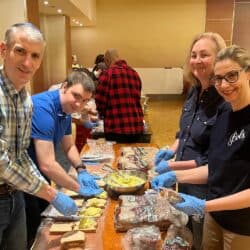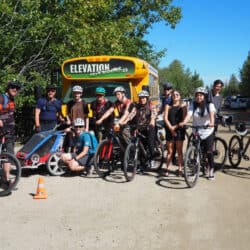With their collective ownership model, community land trusts have the opportunity to work with provincial and federal governments to provide affordable housing and community hubs to marginalized communities.
At six weeks old, in 1995, Shekara Grant was the youngest attendee at the Weymouth Falls community’s biannual reunion. Thirty years later, Grant is the founder of the Weymouth Falls Community Land Trust, working with a team of volunteers to help their community steward their land as a collective.
It started with a contested land deed.
Aubrey Jarvis, who served in the No. 2 Construction Battalion – the first battalion of Black soldiers in Canada – and his wife, Janie R. Jarvis, passed their land in Digby County, Nova Scotia, down to Grant’s great-grandparents. They willed their land to their children, one of whom is Grant’s grandmother, who inherited the land when they died. But in 1978, one of her great-grandparent’s siblings challenged the will. For years, Grant’s family paid property taxes on this land, only to learn their deed had been challenged and overturned. When they stopped paying taxes, the property went up for tax sale, and Grant’s grandmother tried to buy it back. She was unsuccessful, but she kept track of local property tax sales through newspaper clippings in hopes of buying it back. In 2021, Grant found the owner’s address in the property registry and sent them a letter to inquire about purchasing the land. Her efforts were successful and she purchased her family’s land in 2022. But she realized that not understanding the process of using technology to access the land registry online or seeking public information about property ownership at the land registration office was a key barrier for residents. She heard similar stories about other Weymouth Falls families and their land, which prompted her to establish the Weymouth Falls Community Land Trust.
“They were all dispossessed in some way, shape, or form,” Grant says, which inspired her to begin engaging the Black community to work together to reclaim land taken from them.
Land dispossession is not unique to rural Nova Scotia. Several predominantly Black neighbourhoods and organizations across Canada are trying to retrieve land and collectively purchase property to counter gentrification and racist planning policies that have disrupted their communities. Many have established or are working toward a collective ownership model called a community land trust (CLT) to secure this goal. Organized with the intention to acquire and steward land for the benefit of local communities, CLTs are collectively owned and create affordable community spaces and residential housing. But CLTs are not easy to start or maintain. Organizers and networks across Canada are creating more opportunities to share knowledge and simplify the process for other communities.
“Most land trusts, the ones that are most successful, are started, organized, and stewarded by community members,” says Jane O’Brien Davis, the CLT specialist at the Canadian Network of Community Land Trusts (CNCLT), a non-profit that helps CLTs develop or steward permanent affordable housing, land, and other assets for their member communities. Many of the CNCLT staff have urban planning backgrounds, but long-time land trust organizers are also part of their team.
Most land trusts, the ones that are most successful, are started, organized, and stewarded by community members.
Jane O’Brien Davis, Canadian Network of Community Land Trusts
One year ago, at the request of a few Black-led and Black-serving CLTs that shared similar goals and interests, CNCLT began coordinating the “Liberated Land Trust Tour,” to see how US CLTs were managed, exchange resources, and improve their approach to their own community spaces. In May 2024, five teams travelled to the United States: Vancouver’s Hogan’s Alley Society, on the traditional lands of the Musqueam, Squamish, and Tsleil-Waututh nations; Toronto’s Little Jamaica Community Land Trust, on the traditional lands of the Anishinaabeg, Haudenosaunee, and Wendat peoples; and Nova Scotia’s DownTheMarsh Community Land Trust in Truro, the Upper Hammonds Plains Community Land Trust, and the Weymouth Falls Community Land Trust – all situated on the traditional lands of the Mi’kmaw people.
O’Brien Davis emphasizes that these groups are not representative of every Black-led land trust in Canada. They did, however, want to tour land trusts that are Black-led, Black-focused, Black-serving. When they learned that US legislation prohibits racially specific housing provision, they expanded their criteria to include CLTs with mixed-race leadership and implicit focus on Black people.
The Canadian contingent spent three days in California, visiting the Oakland Community Land Trust and East Bay Permanent Real Estate Cooperative, which are situated on the traditional lands of the Ohlone people, followed by two days at the Rondo Community Land Trust in St. Paul, Minnesota, the traditional lands of the Dakota people, and two days at New Communities Inc. in Albany, Georgia, the traditional lands of the Creek Nation.
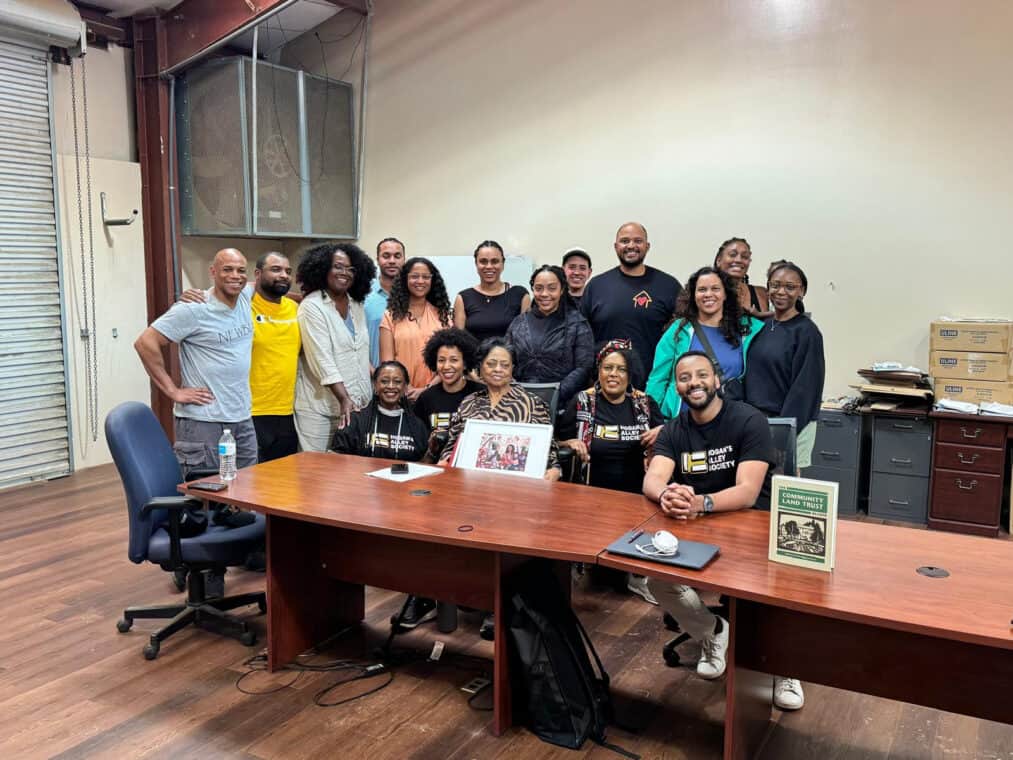
Back row: Germaine Langford, Jordon Jones, Denise Gillard, Brandon David, Shekara Grant, Jane O’Brien Davis, Kaitlyn Patterson, Nat Pace, Curtis Whiley, Melisa Marsman, Anyika Mark, Keisha St. Louis-McBurnie.
Front row: Michelle Cooper-Iversen, Djaka Blais, Shirley Sherrod, June Francis, Petros Kusmu.
Community land trusts reclaiming economic power
“We believe land holds political and economic power for communities, and that it can also be used as a reparative measure,” says Mikeya Griffin, the executive director of the Rondo Community Land Trust.
Rondo’s CLT, the first in its state, was founded in 1993 as a direct response to the devastation caused by the Interstate 94 highway. Its construction destroyed 700 homes and 300 businesses in Rondo, which had a majority Black population. Griffin says that few people knew what a CLT was when they first began. Rondo’s education and advocacy work over the past few decades has led to more mortgage lenders for CLT homes and political support from the Minnesota Housing Finance Agency. Griffin says that the relationships the Rondo CLT has developed with government partners over the years has given them the ability to advocate for more flexibility and access for all CLTs – Black-led or not.
We believe land holds political and economic power for communities, and that it can also be used as a reparative measure.
Mikeya Griffin, Rondo Community Land Trust
Today, Rondo offers affordable residential and commercial property, helping low- and moderate-income families build equity by investing in the land trust model and providing local businesses and seniors commercial and living spaces below market rate. The CLT has made public and private investments to acquire land on behalf of the community. If and when homeowners want to sell, they do so at an affordable price, paying it forward to another member of the community. “I really want us collectively to be able to know that we can create, reshape, and reclaim our inheritances,” Griffin says.
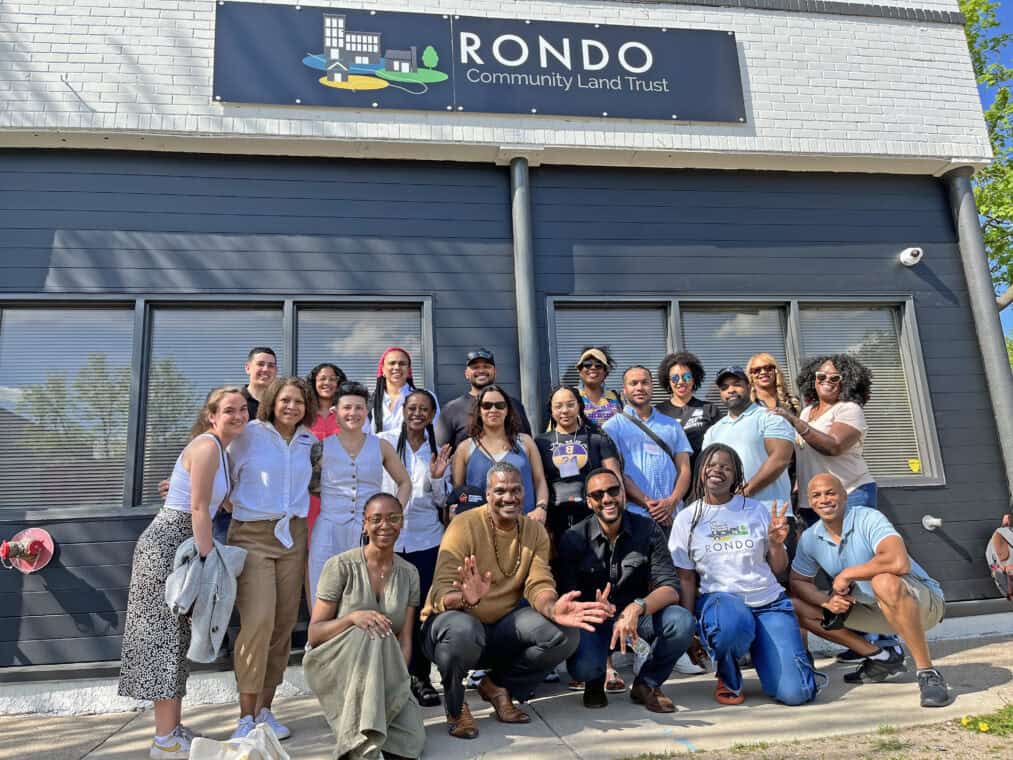
According to the 2024 Minnesota Housing Partnership report, 77% of white people are homeowners compared to 29% of Black people. The state’s housing crisis has left the lowest-income renters with a shortage of 7.1 million affordable homes.
“We can be unapologetic around the fact that there were specific things that happened to communities that deserve to have resources dedicated to having a reparative action,” Griffin says. “We didn’t stop paying our taxes. We didn’t stop participating in the economic system . . . It’s not fair to say that we somehow have our hand held out.”
Every time anyone was looking for examples, we were always directed towards a white organization that was doing it. But when you look at their mission and vision . . . it didn’t actually align with what we were trying to do.
Shekara Grant, Weymouth Falls Community Land Trust
Shekara Grant took part in the Liberated Land Trust Tour, which visited Rondo CLT, and says she is excited to share their programs and strategies with other CLTs – especially those serving Black communities. “Every time anyone was looking for examples, we were always directed towards a white organization that was doing it. But when you look at their mission and vision . . . it didn’t actually align with what we were trying to do,” she says. “I’m not trying to discredit them, because they’re all doing great work, but it just didn’t speak to the context. It didn’t speak to the systemic displacement. It didn’t speak to the fact that if we have low-income housing for everyone, we know that Black people are still going to be underrepresented . . . It also didn’t speak, necessarily, to the importance of place in the same way.”
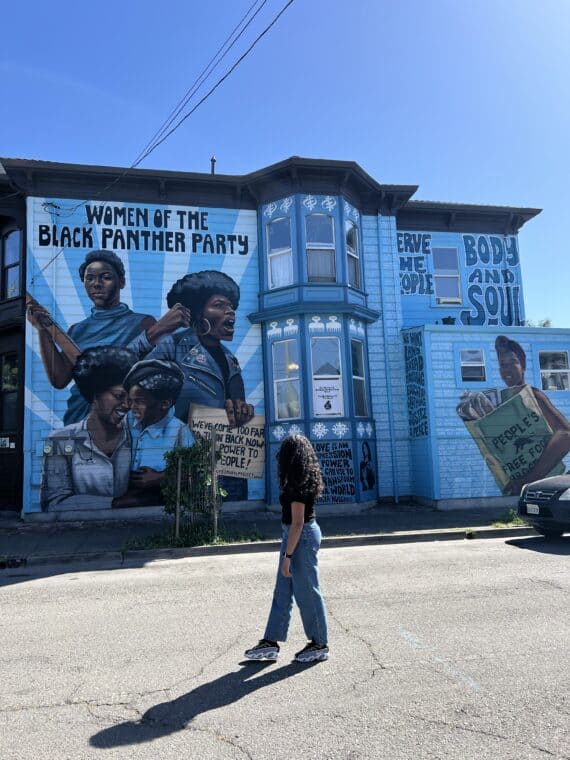
Grant says the African Nova Scotian community’s heritage is deeply rooted in the civil rights movement and pre-abolition times in the United States. Because of this, she says, Black Canadians and African American communities see more similarities with each other, and draw more parallels, compared to what is happening in white communities in Canada. More than 3,000 Black people migrated to Nova Scotia between 1783 and 1785 after the American Revolutionary War, in which Black enslaved people were promised freedom and land in exchange for fighting for Britain. However, white soldiers were also promised land, putting Black Loyalists at the back of the line, and the majority did not receive their promised land. Instead, they worked other land for low wages, facing racism and shortages of food and clothing.
Teaching communities and community land trusts to preserve cultural hubs
While the Weymouth Falls team was inspired by Rondo’s property acquisition for their community, Grants says that “ownership is not necessarily our priority. It really is stewardship.”
The Weymouth Falls team started a community mapping exercise to preserve the oral history of the area, based on what residents and descendants say are important sites in their community. Though Weymouth Falls CLT and the community do not currently own all the places residents mentioned, the community mapping provides them with a guide to prioritize sites and ideas on how to turn the markers into reality. These sites include the Sam Langford Community Centre (named after the heavyweight boxer) and the dam on the Sissiboo River, which generates hydroelectricity for the area. Residents also identified the Mount Beulah Baptist Church. Established in 1853 as the Weymouth Falls United Baptist Church, it was one of seven churches brought together with the formation of the African Baptist Association in 1854 by Weymouth Falls founder Reverend Richard Pearson. The Weymouth Falls Community Land Trust successfully acquired the church in February.
“What we need to be able to do is be responsible to the needs of communities, rather than the needs of a fund,” Grant says. She says that 30 people from the rural community of fewer than 100 are participating in the community engagement programs to provide their insight.
What we need to be able to do is be responsible to the needs of communities, rather than the needs of a fund.
Shekara Grant
“Some of the things that have come up in our community are around people never having had a will,” Grant says. “If we’re trying to start a land trust, our immediate concern is not how can we acquire land, but how can we make sure that less land goes into probate or through tax sales.”
The team is also drafting a guidebook about this process so there is transparency around the costs associated with a project of this size. “I don’t want people to think that they can just call a community meeting and create a community map,” Grant says. She says organizations should be prepared to budget at least $5,000 to complete the process, so professionals like geographic information system specialists can be hired to support them.
Grant says that she would like funding support to make the work Weymouth Falls CLT does more accessible to more communities. She says she is especially inspired by the East Bay Permanent Real Estate Cooperative, who created a cartoon of their bylaws and organization operations on their website to explain their projects. “I think from a funder perspective, they’re not going to see that as a mandatory activity, but in order for my community to understand what’s going on, I actually think that is quite mandatory,” she says.
The most significant investment Weymouth Falls CLT has received is from the federal government’s Supporting Black Canadian Communities Initiative, a funding program that provided $200 million over the past four years to support capacity-building for Black-serving organizations. Weymouth Falls CLT received just over $100,000.
“Our biggest concern is just keeping the community afloat and ensuring that they have an adequate livelihood,” Grant says.
Finding the right partnerships
Two hundred and fifty kilometres east of Weymouth Falls is Upper Hammonds Plains, home of the Upper Hammonds Plains CLT, which launched the Upper Hammonds Plains Housing Co-operative – a project that received $61.2 million from the Canada Mortgage and Housing Corporation in March. Thanks to this funding, the co-op will have 136 housing units, primarily for Black Canadians.
Curtis Whiley, the founder and president of the Upper Hammonds Plains CLT, says that when the federal government announced the co-operative housing development program in June 2024, the Upper Hammonds Plains community expressed that co-ops were one of the affordable housing models they wanted to pursue. “It’s a more participatory structure,” Whiley says. While the CLT is the developer, asset manager, and owner of units, it is an incubator for the co-op. The unit tenants are considered members and can help steward the organization to by joining governance committees.
Folks never actually got possession. We’re about to prove that we can actually reclaim lands in our community via tracing titles.
Curtis Whiley, Upper Hammonds Plains CLT
Whiley says the CLT is also looking to buy land that can be traced to Black communities that originally settled in the area. “Folks never actually got possession. We’re about to prove that we can actually reclaim lands in our community via tracing titles,” he says.
Upper Hammonds Plains CLT is also partnering with Emmanuel Baptist Church to develop two parcels of land.
Whiley also sent invitations to some of the Mi’kmaw nations living near the community to discuss how they can work together on affordable housing for their communities. Whiley says his team has not been able to coordinate meetings yet, but they intend to focus on what housing projects are possible, especially since the CMHC funding will support capacity for some team members to work at the Upper Hammonds Plains CLT full-time.
In March, Public Services and Procurement Canada partnered with CMHC and the Mi’kmaw Native Friendship Society to deliver and operate affordable housing redevelopments for Indigenous people.
“There’s been a lot of injustices to the Indigenous community as well, and so working closely with them to visualize their own sovereignty around how they want to create, claim, reclaim land – they can do that through the community land trust,” says Rondo CLT’s Mikeya Griffin, who coordinated with the Upper Hammonds Plains team from the early stages of their co-operative housing program project. She also visited Upper Hammonds at the beginning of April to see the work the CLT had done. “We’re here to support all of those movements too. It’s a delicate balance because we do acknowledge that we sit on unceded land here too . . . We work together, individually and collectively, to ensure that we have land that works in perpetuity for communities.”
It’s a delicate balance because we do acknowledge that we sit on unceded land here too . . . We work together, individually and collectively, to ensure that we have land that works in perpetuity for communities.
Mikeya Griffin
In Ontario, the construction of the Eglinton Crosstown Light Rail Transit has disrupted homes and businesses in what was once a predominantly Black, Jamaican hub in Toronto. “The construction company that was going through the process was very dismissive. They had absolutely no interest in working with community members,” says Anyika Mark, project coordinator and community engagement manager at the Little Jamaica CLT. “The destruction was just so visceral.”
This led Mark and other concerned residents to begin Black Urbanism TO, a non-profit that engages with the community on urban planning models to protect the neighbourhood. “It’s a non-negotiable that we’re also preserving small business,” Mark says. She says migrants from the 1950s, ’60s, and ’70s were residents who also owned businesses in the buildings for as long as they lived in the neighbourhood; those buildings are now being destroyed. “These mixed-use buildings are so multifaceted. That’s really our major focus: we want to be able to take those off of the market and keep those in community control, because we can create holistic communities,” she says. “There really is power and strength in stacking private funding as well and figuring out what the approach is to getting investors on board to the [CLT] model.”
Mark says Little Jamaica CLT has been working with the Toronto Chinatown Land Trust and the Kensington Market CLT because they are two cultural enclaves in the city that also want to protect small businesses from being destroyed. “Small business is part of the livelihood of our community,” Mark says.
The CNCLT’s Community Land Trust Summit is another opportunity for organizations to learn from each other and collaborate. This year’s summit will be its third iteration, taking place in Halifax. Mark says that there are conversations about holding an international Black CLT summit too, as people are excited to learn how the land trust movement will progress in the future.
“Ultimately, we want to continue that strong Black presence where the land trust is Black-led, Black-focused, Black-serving. They are the board, they are the members, they are the CLT users. They’re the cultural leaders that are doing cultural activations that help to support the land trust,” Mark says. “I think Black folks deserve that, especially in Toronto – how much culture we’ve made, how much we’ve given to the city. We deserve to be leaders of our own neighbourhoods and our own stories.”
Editor’s note: This article was updated on May 7, 2025, to clarify comments from Anyika Mark, project coordinator and community engagement manager at the Little Jamaica CLT.
Editor’s note: This article was updated on May 12, 2025, to correct the date that Rondo’s CLT was founded.
